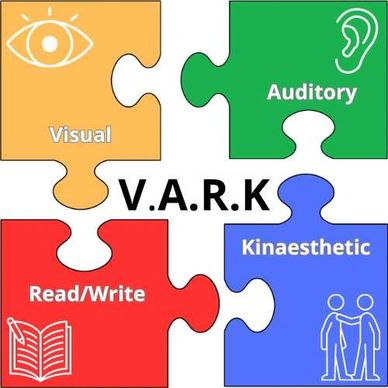Metacognition and Critical thinking
VARK learning preferences
Critical and Creative Thinking - General Capabilities
Critical and Creative Thinking - General Capabilities

The VARK questionnaire is a valuable tool to help build metacognitive process. - "Finding out and thinking about your VARK preferences improves metacognitive knowledge" (Lander, 2024).
Three ways that the VARK tool can support metacognitive process are:
1. helping you think about how you learn and the modality preferences that support learning.
2. identifying different strategies for learning, based on VARK preferences and task.
3. suggesting changes to learning behaviours to improve learning
"When people make changes to their learning, based on their VARK preferences, their learning will be enhanced. They do this by using strategies that align with their preferences. It is what you do after you learn your preferences that has the potential to make a difference" - Heather Lander, Manager VARK Learn Limited, 2024
I encourage all students, teachers, and learners more broadly, to explore their VARK learning preferences. Here are some quick links to get you started:
- How to use VARK® to improve learning: A guide for teachers (vark-learn.com)
- VARK Questionnaire: How do you learn best? (vark-learn.com)
- The VARK® Questionnaire for Younger People - VARK (vark-learn.com)
- How to use Multimodal strategies for Education (vark-learn.com)
Critical and Creative Thinking - General Capabilities
Critical and Creative Thinking - General Capabilities
Critical and Creative Thinking - General Capabilities

These are general capabilities in both the Australian Curriculum v9.0 and the Victorian Curriculum V2.0
- Critical and Creative Thinking - Scope and Sequence - Victorian Curriculum (vcaa.vic.edu.au)
- F-10 Curriculum | Critical and Creative Thinking (australiancurriculum.edu.au)
Critical Thinking is clear, rational, logical and independent thinking. It is improving thinking by analysing, assessing and reconstructing how we think. It also means thinking in a self-regulated and self-corrective manner. It’s thinking on purpose!
Critical thinking involves
- mindful communication,
- problem-solving
- a freedom from bias or egocentric tendency.
Four habits of thought central to Critical thinking are:
- Recognising assumptions and generalisations
- Taking account of context
- Imaging alternatives
- Developing doubt and curiosity
De Bono's Thinking Hats
Critical and Creative Thinking - General Capabilities
De Bono's Thinking Hats

One of the simplest ways to explore thinking critically is to use DeBono's Thinking hats. The six colour hats represent different lenses or dispositions through which thinking, and decision making can happen. When you switch between them, you automatically broaden your critical perspectives as you consider different functions and roles:
- BLACK - Cautions and Challenges. Identifying risks, dangers, weaknesses and possible problems.
- GREEN - Alternatives and Creative Ideas. Identifying possibilities, options, alternate pathways to a solution. Requires divergent thinking.
- WHITE - the facts and available data. This is the information on hand that is known. It is objective and provides context and scope based on what is known.
- YELLOW - the benefits and the positives. Optimistic approach, identifying strengths and the potential value.
- BLUE - the process, planning and organisation. This is the hat that helps you move between the hats, driving the questions of what, why, how, why not and so on. Requires you to think about thinking.
- RED - feelings and emotions. Taps into gut instinct and intuition. How it makes you feel, subjective and personal.
Copyright © 2025 jhameducation.com.au - All Rights Reserved.
.png/:/rs=h:200,cg:true,m/qt=q:100/ll)
.png/:/rs=h:104,cg:true,m/qt=q:100/ll)